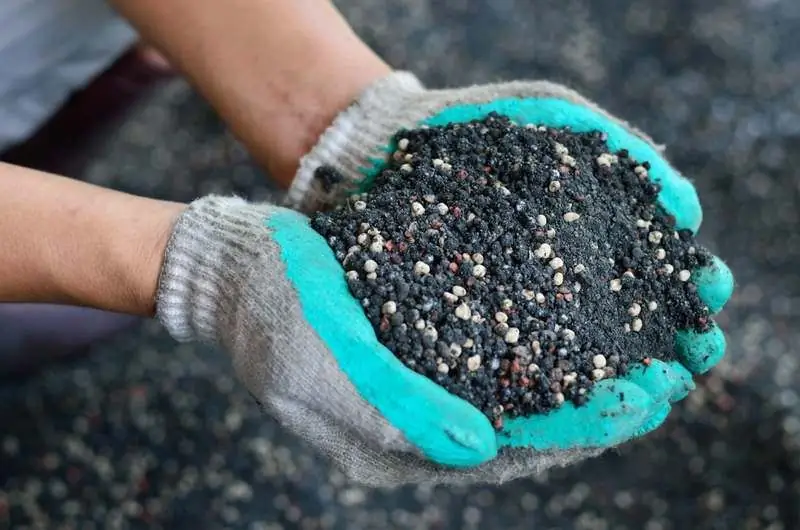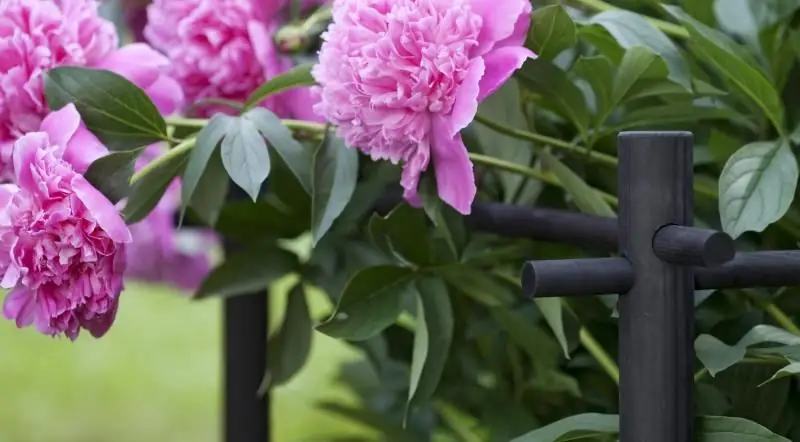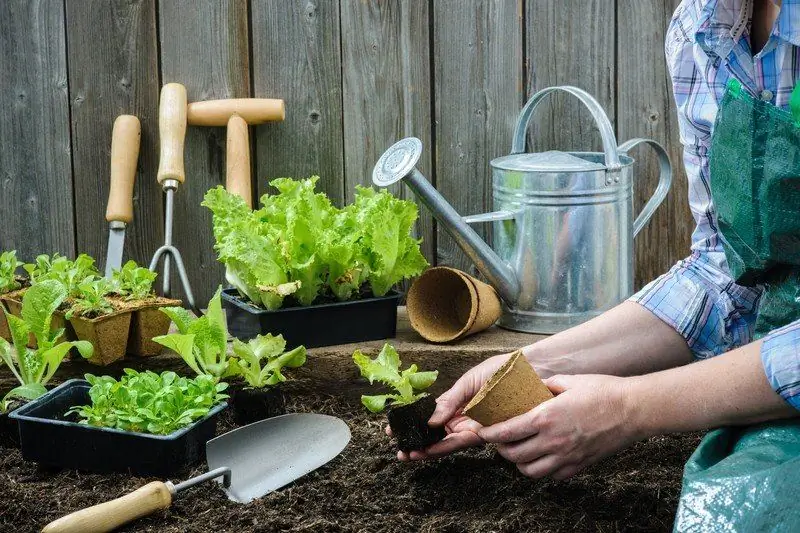
Table of contents:
- Author Bailey Albertson [email protected].
- Public 2023-12-17 12:53.
- Last modified 2025-06-01 07:32.
Autumn fertilizers for the garden and vegetable garden: we take care of the future harvest in advance

Cold autumn is a hot season for gardeners. It is necessary to have time to prepare the vegetable garden and garden for the winter frosts. To ensure a successful wintering, among other activities, autumn feeding of plants will help. Thanks to the competent and timely application of fertilizers in the fall, the plants will survive the winter well, wake up faster in the spring and give a greater harvest in the summer.
Content
- 1 Goals and timing of autumn plant nutrition
-
2 Types of autumn fertilizers
- 2.1 Organic
- 2.2 Mineral
- 2.3 Complex
-
2.4 Siderata
2.4.1 Video: planting green manure in the fall
-
3 Fertilizers for digging a garden: application features
3.1 Video: how to feed the soil before digging
-
4 Technology of fertilization of perennial plants in the garden
-
4.1 Fruit trees and berry bushes
4.1.1 Video: how to compost under fruit trees
- 4.2 Flowering perennials
-
Goals and timing of autumn plant nutrition
Autumn is the best time for fertilizing the soil. Beneficial bacteria living in the soil, after harvesting, process the incoming substances faster, retain them longer. Summer residents have little worries compared to summer, and there is more time for high-quality feeding of the beds. In addition, filling the soil with fertilizers in the fall will free up more time for spring work.

Autumn is the best time to feed plants and fertilize for digging
The main task of the autumn feeding of plants is to prepare them for winter, providing them with the necessary nutrients
Autumn feeding does not begin in the fall, but even in the summer (this applies to crops that bear fruit early and once a season). When fertilizing for different crops:
- strawberries - end of June;
- strawberries - July-August, depending on the variety;
- currants, gooseberries - August;
- raspberries - August and September;
- fruit trees - August and September;
- onions, herbs - August;
- carrots and beets - end of September;
- cabbage - October;
- potatoes - September;
- annual flowers - September;
- perennial flowers - end of September.

Cabbage is one of the latest crops in the garden, after harvesting the soil is fertilized in October
The deadline for applying fertilizers in autumn in central Russia is early October, since later they simply will not be assimilated. Plants will go into a dormant phase and will not take the necessary nutrients from the ground. In the southern regions, you can feed the plants until November.
Types of autumn fertilizers
Distinguish between mineral, organic and complex autumn dressings. For perennial plants, it is better to apply all fertilizers in liquid form so that they are absorbed faster. If we are talking about preparing the beds for the spring planting of annual crops, then you can use granular or other non-liquid forms.
Organic
These fertilizers include:
-
horse manure - considered the best, as it contains a maximum of nutrients, including nitrogen. During the winter, nitrogen will be well absorbed by the soil and in the spring the plants will receive it in full. Application rate - 3 kg per 1 m 2;

Horse dung Horse manure is considered the best in terms of nutrient content
- mullein - also contains a lot of nitrogen. It can be applied fresh only in autumn, since the ammonia included in its composition is harmful to plants, and during the winter its compounds will have time to erode from the soil. Consumption rate - 5 kg per 1 m 2;
- ash is rich in potassium. In autumn it is necessary only on clayey soils. In other types of soils, it will not linger and will be washed out by spring during the melting of the snow. Fertilizer rate - 1 glass per 1 m 2;
- compost - when properly prepared, contains all the nutrients plants need. For better assimilation, it is laid out on beds cleared of weeds, watered with any EM preparation and loosened with earth. During the winter, the compost is processed by soil bacteria;
-
poultry manure is the most concentrated organic fertilizer and because of this property it is dangerous for plants (it has to be diluted 20 times and watered very carefully, trying not to get on the leaves). Ideal for digging fertilizer as it can then be used without dilution. Application rate - 1 glass per 1 m 2.

Chicken droppings Chicken Dung - Concentrated Organic Fertilizer
Mineral
The main rule when choosing mineral autumn fertilizers is that they should contain a minimum of nitrogen, a maximum of phosphorus and potassium
The standard, well-known, mineral autumn fertilizer is simple or double superphosphate. It contains phosphorus, a trace element that is very slowly absorbed by the soil. Only by spring will it completely dissolve and will be used by plants. For better assimilation of phosphorus, it is added to the ground along with potassium. Superphosphate application rates:
- simple - 40 g per 1 m 2;
-
double - 20 g per 1 m 2.

Double superphosphate Double superphosphate is an effective nitrogen-phosphorus fertilizer
In addition to superphosphate, fertilize the soil in autumn:
- phosphate rock - added together with manure on alkaline and soddy-podzolic soils 20 g per 1 m 2;
- potassium sulfate - used to increase the winter hardiness of berry bushes, the norm is 30 g per 1 m 2;
- calcium chloride - chlorine, which many plants cannot tolerate, will be washed out of the soil in six months, and useful calcium will remain. The norm is 20 g per 1 m 2.
Complex
Fertilizers contain several substances in the concentrations required for this time of year:
-
Fertika “Garden and vegetable garden. Autumn”- maximum potassium and phosphorus, minimum nitrogen and some trace elements from calcium to zinc;

Fertika autumn Fertika autumn fertilizer contains a maximum of potassium and phosphorus
- Bona Forte “Universal. Summer - Autumn”- contains the main elements and auxiliary ones that help to assimilate them (sulfur and magnesium), increases the frost resistance of plants. Apply in an amount of 30-60 g per 1 m 2;
- "Autumn" of the "Buyskie Fertilizers" company is organic-mineral, contains more potassium, is used for digging in an amount of 20-30 g per 1 m 2.
Siderata
Currently, more and more gardeners are planting green manure to fertilize their beds in the fall. These are mainly annual grasses, the roots of which improve the structure of the soil, and the greens themselves, after rotting, become an excellent organic fertilizer.

Green manure roots improve soil structure by loosening it
Suitable siderates for autumn planting:
- mustard white;
- vetch or vetch-oat mixture;
- rye;
- oats;
- oil radish.
Green fertilizer is planted immediately after harvesting (that is, in summer and early autumn), the grass is waited to grow up to 15-20 cm and mowed. It is important that the plants do not bloom, otherwise, instead of fertilizing the next year, they will come out like weeds.
Video: planting siderates in the fall
When sowing siderates after early crops, when they grow back in the summer, they can be mowed and re-planted. If you plant siderates late, you can not mow them, but simply leave them in the garden - the roots will loosen the soil until the very cold, and the greens will rot into an excellent fertilizer during the winter and, moreover, will act as a snow holder.

Siderata mown and left in the garden helps to retain snow
On our site next to the forest, the soils are heavy, infertile, 20 cm of clay, and then sand. She sowed green manure without burying them in the soil. In the spring, no processing of green fertilizer happened, as the green manure lay in the garden bed, and they lie. The same happened with the manure, although it was rotted. Since then, I have always dug up a little all the grass mowed in the garden, and covered the manure with a layer of earth. The result is excellent - the soil is loose in spring, and there is no trace of autumn fertilizers.
Fertilizers for digging a garden: application features
Before applying any fertilizers, you need to clear the beds of weeds, especially carefully choosing the roots of perennials: sow thistle, dandelion, nettle and others. If it is not possible to fertilize the soil immediately, it should be mulched for a while.
All mineral granular fertilizers are scattered over the soil surface and then dug up to a depth of 20-25 cm so that the granules are in the lower soil layer and dissolve well over the winter. In order not to damage the fertile humus, it is better to use not a shovel, which turns the soil layers, but a pitchfork or a flat cutter - they loosen the soil without damaging it.

When digging the soil with a pitchfork, its structure is damaged less
Manure, compost and other organic matter are also mixed with soil.
Video: how to feed the soil before digging
Fertilization technology for perennial plants in the garden
Perennial garden plants in the fall require mandatory feeding before wintering.
Fruit trees and berry bushes
Mineral fertilizers are applied to the trunk circle. You can make holes and add top dressing to them, or spread fertilizers around the perimeter around the trunk (300 g per tree, 150 g per bush) and then bury them in the soil. After that, watering with plenty of water is required (10 liters per bush, 30 liters per tree).

When feeding fruit trees in the fall, fertilizer is applied to the trunk circle
Organic fertilizers, such as manure or compost, can be used as mulch, but be careful: pest larvae can hibernate in them, so it is worth taking only heavily rotted fertilizer (30-50 kg per tree, 3 kg per bush).
Video: how to compost under fruit trees
To prevent the appearance of pests, you can sprinkle the ground around trees or bushes with a centimeter layer of wood ash. During the winter, it will be absorbed into the soil and also fertilize it.
Blooming perennials
Mandatory feeding for perennials after flowering. At this time, the plants not only prepare for winter, but also lay flower buds for the next year. Organics are not suitable for all colors. For example, daffodils, tulips, hydrangeas can die from it - it is better to fertilize them with specialized mineral compositions. Most perennials respond well to potash fertilizing.

Perennial flowers need feeding to lay flower buds for next year
In order for all plants to start growing together in spring, it is necessary to provide them with a comfortable wintering. One of the mandatory activities in the autumn garden is plant feeding and fertilizing the soil. You can use any fertilizer, the main thing is to follow the application technology and dosage.
Recommended:
Fences For Garden Beds With Your Own Hands - How To Make A Fence For A Front Garden, Flower Garden Or Vegetable Garden, Step By Step Instructions With A Photo

Options for fences for a suburban area. Their pros and cons. How to install a holder for plastic bushes, a flower bed from bottles: step by step instructions. Video
What Can Be Planted In June In The Country: Plants For The Garden, Vegetable Garden And Flower Garden

Plants suitable for planting in the garden in June are greens, roots, other vegetables, flowers. What can be planted in open ground and in a greenhouse. Gardener's recommendations
Manicure Autumn - Fashionable Autumn Trends In Nail Design And Photos Of Beautiful New Products

What fashion trends are relevant in manicure in the fall of 2019 What techniques should be used. Various styles, colors and other nuances
What Insects Are Beneficial In The Garden And Vegetable Garden

What beneficial insects can be used to get rid of pests in the garden and vegetable garden
Important Things In The Garden And Vegetable Garden In The Fall

Autumn work in the garden and garden, which should not be forgotten
